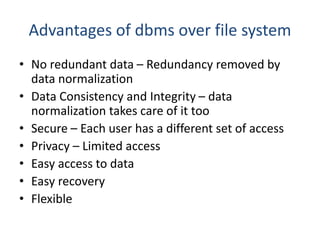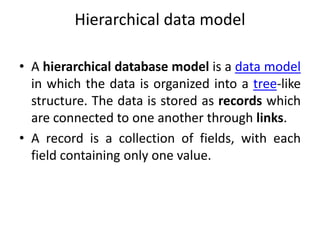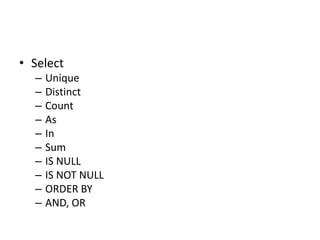Ad
introduction-to-dbms-unit-1.ppt
- 2. Course Objectives • To understand purpose of database management system • Apply concepts like database design and database languages in managing data • Importance of normalization in dbms and SQL in implementation of database access • Knowledge of transaction control , recovery strategies , storage and indexing etc
- 4. Text Book 1.Database Management Systems, Raghurama Krishnan, Johannes Gehrke (2007), 3rd Edition, Tata McGraw-Hill, New Delhi, India 2.Database System Concepts Abraham Silberschatz, Henry F. Korth, S. Sudarshan (2010), 6th Edition, McGraw-Hill, New Delhi, India.
- 6. Roles • Data Engineer • Data Scientist etc
- 7. History of database systems • Integrated Data Store, First general purpose DBMS by charles bachman at General Electric.[Network Model] • IBM’s Information Management System(IMS)[hierachial data model] • SABRE system for making airline reservations By American airlines and IBM • In 1970,at IBM’s San Jose Research laboratory proposed relational data model • In 1980’s, SQL for relational databases by IBM • Database transaction management james gray 1999 • IBM’s DB2, Oracle 8, Informix UDS • ERP and MRP • DBMS with internet • Multimedia databases, streaming data, digital libraries ,NASA’s earth observation system project • Decision making and mining data repositories
- 8. Introduction to database management systems • Data: Data represents known facts or raw information in unorganized form (such as alphabets or numbers or symbols ) . • Database: Database is a organized collection of data describing the activities of one or more related organizations. • Database management system(DBMS) is a software designed to assist in storing, maintaining and utilizing large collections of data. or A database-management system (DBMS) is a computer-software application which interacts with end-users, other applications, and the database itself to access,update,manage and analyze data with the help of set of application programs.
- 9. Advantages of Database management systems • Data Independence • Efficient data access • Data integrity and security • Data administration • Concurrent access and crash recovery • Reduced application development time
- 11. Database systems Vs file systems • File storage refers to a collection of operating system files. • DBMS features to manage the data in a robust and efficient manner.
- 12. Advantages of dbms over file system • No redundant data – Redundancy removed by data normalization • Data Consistency and Integrity – data normalization takes care of it too • Secure – Each user has a different set of access • Privacy – Limited access • Easy access to data • Easy recovery • Flexible
- 13. View of data • Abstraction • Data Abstraction • Instance and schema
- 14. • Abstraction :Hiding unnecessary details from the user and providing abstract view of data which is required to users. • Data Abstraction: Database systems are made-up of complex data structures. To ease the user interaction with database, the developers hide internal irrelevant details from users. This process of hiding irrelevant details from user is called data abstraction.
- 15. Schema • Design of a database is called schema. • 3 types: – Physical schema – Logical schema – View schema
- 16. Data models • Data models determines the logical structure of a database • A Data Model is a logical structure of Database. It describes the design of database to reflect entities, attributes, relationship among data, constrains etc.
- 17. Data models • Relational data model • Entity – relationship model • Hierarchical data model • Network model • Object oriented model • Object relational model • Semi structured data model • Flat data model
- 18. Hierarchical data model • A hierarchical database model is a data model in which the data is organized into a tree-like structure. The data is stored as records which are connected to one another through links. • A record is a collection of fields, with each field containing only one value.
- 19. Example for hierarchical model
- 20. Example of hierarchical model
- 22. Network model • In the network model, entities are organized in a graph, in which some entities can be accessed through several paths.
- 23. Network data model example
- 24. Example for network model
- 25. Object oriented data model • This data model is another method of representing real world objects. • It considers each object in the world as objects and isolates it from each other. • It groups its related functionalities together and allows inheriting its functionality to other related sub-groups.
- 27. Object relational data model • An object-relational database (ORD), or object-relational database management system (ORDBMS), is a database management system (DBMS) similar to a relational database, but with an object-oriented database model: objects, classes and inheritance are directly supported in database schemas and in the query language
- 28. Semi structured data model: The semi-structured data model is designed as an evolution of the relational data model that allows the representation of data with a flexible structure. Semi-structured data model is model where schema is part of data
- 32. • Select – Unique – Distinct – Count – As – In – Sum – IS NULL – IS NOT NULL – ORDER BY – AND, OR
- 33. Database users and administration • Database users 1. Application Programmers 2. Sophisticated users 3. Specialized users 4. Stand-alone users 5. Native Users
- 34. Database administrators • Responsibilities of DBA: – Installing and upgrading DBMS servers – Design and implementation of databases – Schema definition , storage structure, access method definition – Performance Tuning – Migrate database servers – Backup and recovery – Security – Documentation etc
- 35. Types of database administrators • Administrative DBA • Development DBA • Database Architect • Data warehouse DBA • Application DBA • OLAP DBA
- 36. Transaction management • Transaction • Partial transactions • Concurrent execution of transactions • Locking protocol • Locks • Shared locks • Exclusive locks • Incomplete transactions • System crashes • Log • Write Ahead Log (WAL) • Checkpoint • Periodic checkpoints
- 37. Introduction to database design Database design process steps • Requirement Analysis • Conceptual database design • Logical database design • Schema refinement • Physical database design • Application and security design
- 38. E -R diagrams • The E-R data model allows us to describe the data involved in a real-world enterprise in terms of objects and their relationships and is widely used to develop an initial database design.
- 39. entities • An entity is an object in the real world that is distinguishable from other objects. • An Entity can be any object, place, person or class. • an entity is represented using rectangles. Employee Department Works for
- 40. Weak entity Weak entity is an entity that depends on another entity. Weak entity doesn't have key attribute of their own. Double rectangle represents weak entity.
- 41. attributes • An Attribute describes a property or characteristic of an entity. For example, Name, Age, Address etc can be attributes of a Student. An attribute is represented using eclipse
- 42. Types of attributes • Key attribute • Composite attributes • Derived attributes
- 43. relationships • A Relationship describes relations between entities. Relationship is represented using diamonds • Relationship is an association among 2 or more entities • There are three types of relationship that exist between Entities. • Binary Relationship • Recursive Relationship • Ternary Relationship
- 44. relationship sets • Collection of set of similar relationships is called a relationship set.
- 45. additional features of the E -R model • Key constraints • Key constraints for ternary relationships • Participation constraints(partial and complete) • Class hierarchies • Aggregation
- 46. conceptual design with the E-R model • Entity versus attribute • Entity versus relationship • Binary versus ternary relationships • Aggregation versus ternary relationships
- 47. conceptual design for large enterprises
- 48. • A college contains many departments • Each department can offer any number of courses • Many instructors can work in a department • An instructor can work only in one department • For each department there is a Head • An instructor can be head of only one department • Each instructor can take any number of courses • A course can be taken by only one instructor • A student can enroll for any number of courses • Each course can have any number of students
- 49. • Step 1 : Identify the Entities • Stem 2 : Identify the relationships • Step 3: Identify the key attributes • Step 4: Identify other relevant attributes • Step 5: Draw complete ER diagram
- 50. • Step 1 : Identify the Entities What are the entities here? From the statements given, the entities are • Department • Course • Instructor • Student
- 51. Stem 2 : Identify the relationships • One department offers many courses. But one particular course can be offered by only one department. hence the cardinality between department and course is One to Many (1:N) • One department has multiple instructors . But instructor belongs to only one department. Hence the cardinality between department and instructor is One to Many (1:N) • One department has only one head and one head can be the head of only one department. Hence the cardinality is one to one. (1:1) • One course can be enrolled by many students and one student can enroll for many courses. Hence the cardinality between course and student is Many to Many (M:N) • One course is taught by only one instructor. But one instructor teaches many courses. Hence the cardinality between course and instructor is Many to One (N :1)
- 52. • Step 3: Identify the key attributes • "Departmen_Name" can identify a department uniquely. Hence Department_Name is the key attribute for the Entity "Department". • Course_ID is the key attribute for "Course" Entity. • Student_ID is the key attribute for "Student" Entity. • Instructor_ID is the key attribute for "Instructor" Entity.
- 53. • Step 4: Identify other relevant attributes • For the department entity, other attributes are location • For course entity, other attributes are course_name,duration • For instructor entity, other attributes are first_name, last_name, phone • For student entity, first_name, last_name, phone
- 56. • A typical example could be entities Customer, Order, and Product. • An instance of the Customer entity is identified by a unique customer number, • an instance of the Order entity is identified by a unique order number, and • an instance of the Product entity is identified by a unique product number.






![History of database systems
• Integrated Data Store, First general purpose DBMS by charles bachman at General
Electric.[Network Model]
• IBM’s Information Management System(IMS)[hierachial data model]
• SABRE system for making airline reservations By American airlines and IBM
• In 1970,at IBM’s San Jose Research laboratory proposed relational data model
• In 1980’s, SQL for relational databases by IBM
• Database transaction management james gray 1999
• IBM’s DB2, Oracle 8, Informix UDS
• ERP and MRP
• DBMS with internet
• Multimedia databases, streaming data, digital libraries ,NASA’s earth observation
system project
• Decision making and mining data repositories](https://image.slidesharecdn.com/introduction-to-dbms-unit-1-240123131108-834fffc9/85/introduction-to-dbms-unit-1-ppt-7-320.jpg)
































































































